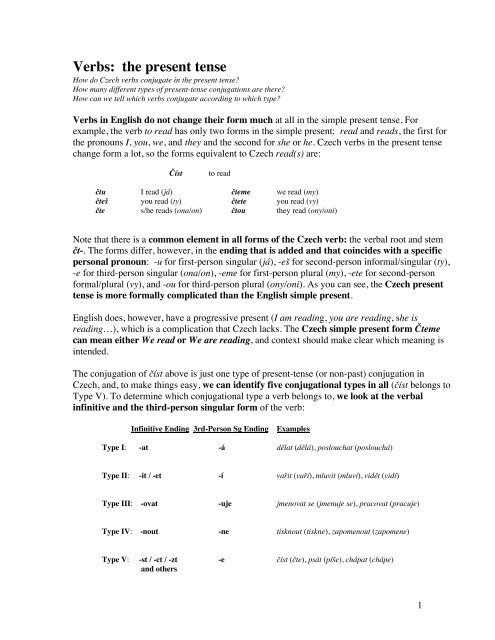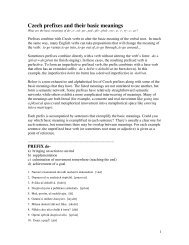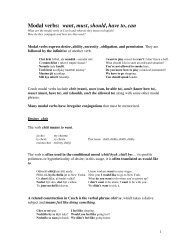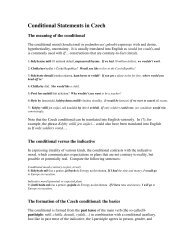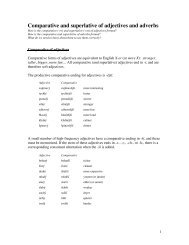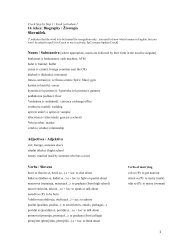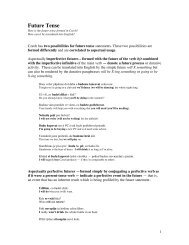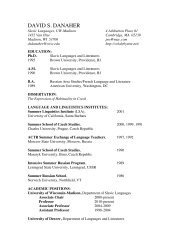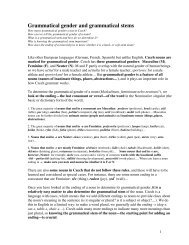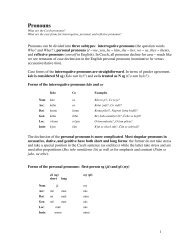Verbs: the present tense - Cokdybysme.net
Verbs: the present tense - Cokdybysme.net
Verbs: the present tense - Cokdybysme.net
You also want an ePaper? Increase the reach of your titles
YUMPU automatically turns print PDFs into web optimized ePapers that Google loves.
<strong>Verbs</strong>: <strong>the</strong> <strong>present</strong> <strong>tense</strong><br />
How do Czech verbs conjugate in <strong>the</strong> <strong>present</strong> <strong>tense</strong><br />
How many different types of <strong>present</strong>-<strong>tense</strong> conjugations are <strong>the</strong>re<br />
How can we tell which verbs conjugate according to which type<br />
<strong>Verbs</strong> in English do not change <strong>the</strong>ir form much at all in <strong>the</strong> simple <strong>present</strong> <strong>tense</strong>. For<br />
example, <strong>the</strong> verb to read has only two forms in <strong>the</strong> simple <strong>present</strong>: read and reads, <strong>the</strong> first for<br />
<strong>the</strong> pronouns I, you, we, and <strong>the</strong>y and <strong>the</strong> second for she or he. Czech verbs in <strong>the</strong> <strong>present</strong> <strong>tense</strong><br />
change form a lot, so <strong>the</strong> forms equivalent to Czech read(s) are:<br />
Číst<br />
to read<br />
čtu I read (já) čteme we read (my)<br />
čteš you read (ty) čtete you read (vy)<br />
čte s/he reads (ona/on) čtou <strong>the</strong>y read (ony/oni)<br />
Note that <strong>the</strong>re is a common element in all forms of <strong>the</strong> Czech verb: <strong>the</strong> verbal root and stem<br />
čt-. The forms differ, however, in <strong>the</strong> ending that is added and that coincides with a specific<br />
personal pronoun: -u for first-person singular (já), -eš for second-person informal/singular (ty),<br />
-e for third-person singular (ona/on), -eme for first-person plural (my), -ete for second-person<br />
formal/plural (vy), and -ou for third-person plural (ony/oni). As you can see, <strong>the</strong> Czech <strong>present</strong><br />
<strong>tense</strong> is more formally complicated than <strong>the</strong> English simple <strong>present</strong>.<br />
English does, however, have a progressive <strong>present</strong> (I am reading, you are reading, she is<br />
reading…), which is a complication that Czech lacks. The Czech simple <strong>present</strong> form Čteme<br />
can mean ei<strong>the</strong>r We read or We are reading, and context should make clear which meaning is<br />
intended.<br />
The conjugation of číst above is just one type of <strong>present</strong>-<strong>tense</strong> (or non-past) conjugation in<br />
Czech, and, to make things easy, we can identify five conjugational types in all (číst belongs to<br />
Type V). To determine which conjugational type a verb belongs to, we look at <strong>the</strong> verbal<br />
infinitive and <strong>the</strong> third-person singular form of <strong>the</strong> verb:<br />
Infinitive Ending 3rd-Person Sg Ending<br />
Examples<br />
Type I: -at -á dělat (dělá), poslouchat (poslouchá)<br />
Type II: -it / -et -í vařit (vaří), mluvit (mluví), vidět (vidí)<br />
Type III: -ovat -uje jmenovat se (jmenuje se), pracovat (pracuje)<br />
Type IV: -nout -ne tisknout (tiskne), zapomenout (zapomene)<br />
Type V: -st / -ct / -zt -e číst (čte), psát (píše), chápat (chápe)<br />
and o<strong>the</strong>rs<br />
1
When you learn a new verb in Czech, be sure to figure out which conjugational type it<br />
belongs to so that you’ll know how it conjugates. Most verbs fit into one of <strong>the</strong>se types,<br />
although <strong>the</strong>re are some (like být or vědět) that are just irregular and <strong>the</strong>ir forms must be<br />
memorized.<br />
Details of each conjugational type—along with examples of <strong>the</strong>ir use—are below:<br />
Type I: -at; -á<br />
Endings: -ám, -áš, -á, -áme, -áte, -ají<br />
já: dělám my: děláme<br />
ty: děláš vy: děláte<br />
ona/on: dělá<br />
oni/oni: dělají<br />
Many verbs belong to <strong>the</strong> straightforward Type I. They include very common verbs like říkat<br />
(to say), dívat se (to look at), obědvat (to eat lunch), běhat (to run), and zpívat (to sing).<br />
Neříkám, že to není možné.<br />
possible<br />
Turisté se dívají na Pražský hrad.<br />
castle<br />
Obědváme u vodopádu.<br />
by waterfall<br />
David běhá rychleji než Tomáš.<br />
faster than<br />
Zpíváš si doma ve sprše<br />
shower<br />
verb: říkat<br />
verb: dívat se<br />
verb: obědvat<br />
verb: běhat<br />
verb: zpívat (si)<br />
-------------------------------------------------------------------------------------------------------------<br />
Type II: -it/-et; -í Endings: -ím, -íš, -í, -íme, -íte, -í (-ejí/-ějí)<br />
já: mluvím my: mluvíme<br />
ty: mluvíš vy: mluvíte<br />
ona/on: mluví oni/oni: mluví<br />
<strong>Verbs</strong> that fall into Type II include učit se (to learn or study), jezdit (to go by vehicle), vidět (to<br />
see), bydlet (to live), and muset (must, to have to).<br />
Učí se vařit pivo, ale sám ho nepije. verb: učit se<br />
to brew but himself it doesn’t-drink<br />
Na kole jezdíme s rodinou relativně často.<br />
bike with family often<br />
Teď vidím svět trošku jinak.<br />
now world a-bit differently<br />
verb: jezdit<br />
verb: vidět<br />
2
Bydlíš na koleji nebo v bytě<br />
in dorms or apartment<br />
verb: bydlet<br />
100 filmů, které musíte před smrtí vidět. verb: muset<br />
which before death<br />
Some verbs in -et fall into a subtype with one variant ending: <strong>the</strong> third-person plural form<br />
ends in -ejí or -ějí. <strong>Verbs</strong> in this subtype in standard Czech include umět (to know how to),<br />
rozumět (to understand), and prefixed verbs of motion like přicházet (to come or arrive) and<br />
odcházet (to go away or leave).<br />
Proč neumějí plavat<br />
why to-swim<br />
Češi penězům nerozumějí.<br />
Czechs money<br />
Přicházejí problémy.<br />
Studenti odcházejí pracovat do USA.<br />
to-work to<br />
verb: umět<br />
verb: rozumět<br />
verb: přicházet<br />
verb: odcházet<br />
In colloquial Czech, <strong>the</strong>re is some general confusion among <strong>the</strong> endings in <strong>the</strong> third-person<br />
plural for Type II verbs: -í is sometimes used even for <strong>the</strong> subtype and also <strong>the</strong> -ejí/-ějí ending<br />
(often reduced to -ej/-ěj) can be generalized to regular Type II verbs.<br />
-------------------------------------------------------------------------------------------------------------<br />
Type III: -ovat; -uje Endings: -uji (-uju), -uješ, -uje, -ujeme (-ujem), -ujete, ují (-ujou)<br />
já: pracuji (-uju) my: pracujeme (-ujem)<br />
ty: pracuješ vy: pracujete<br />
ona/on: pracuje oni/oni: pracují (-ujou)<br />
This type includes a large number of verbs, including many everyday ones like potřebovat (to<br />
need), studovat (to study), (po)děkovat (to thank), and tancovat (to dance). Many foreign roots<br />
are re<strong>present</strong>ed in this type like analyzovat, prezentovat, and bombardovat. Alternate endings<br />
in colloquial Czech for first-person singular and plural as well as third-person plural are given in<br />
paren<strong>the</strong>ses.<br />
Kolik informace vlastně potřebujeme<br />
how-much really<br />
verb: potřebovat<br />
Ještě studuju ale zároveň i pracuju. verbs: studovat, pracovat<br />
still but at-<strong>the</strong>-same-time<br />
Děkujeme Ti za všechno!<br />
for everything<br />
Jana tancuje převážně rumbu a sambu.<br />
verb: děkovat<br />
verb: tancovat<br />
3
mostly<br />
Média analyzují Obamův projev.<br />
speech<br />
verb: analyzovat<br />
Proč vychrtlé krásky prezentují módu<br />
why scrawny beauties fashion<br />
Meteority bombardují Měsíc.<br />
moon<br />
verb: prezentovat<br />
verb: bombardovat<br />
Some verbs with monosyllabic infinitives that do not end in -ovat can be placed here; <strong>the</strong> most<br />
common is <strong>the</strong> verb hrát (to play) with <strong>the</strong> verbal stem hraj- (hraji/hraju, hraješ, hraje…).<br />
Hrajeme si loutkové divadlo.<br />
puppet <strong>the</strong>ater<br />
Mluvící papoušek hraje počítačové hry.<br />
talking parrot<br />
games<br />
verb: hrát si<br />
verb: hrát<br />
-------------------------------------------------------------------------------------------------------------<br />
Type IV: -nout; -ne Endings: -nu, -neš, -ne, -neme (-nem), -<strong>net</strong>e, -nou<br />
já: zapomenu my: zapomeneme (-nem)<br />
ty: zapomeneš vy: zapome<strong>net</strong>e<br />
ona/on: zapomene oni/oni: zapomenou<br />
<strong>Verbs</strong> in -nout form a coherent type. Many of <strong>the</strong> verbs here (like zapomenout) are perfective,<br />
which means that <strong>the</strong> conjugational forms given here have a future meaning: <strong>the</strong>y re<strong>present</strong> a<br />
non-past—not a <strong>present</strong>—<strong>tense</strong>. The colloquial variant of <strong>the</strong> first-person plural is given in<br />
paren<strong>the</strong>ses. Some common verbs here are tisknout (to print), hubnout (to lose weight), and<br />
vládnout (to rule, govern, control).<br />
Co mám dělat, když zapomenu přístupové heslo<br />
I-should if log-in<br />
verb: zapomenout<br />
Tiskneme vizitky a letáky. verb: tisknout<br />
business-cards flyers<br />
Jestli sniš méně, hubneš.<br />
if you-eat less<br />
Kolika počítačům vládnou hackeři<br />
how-many<br />
hackers<br />
verb: hubnout<br />
verb: vládnout<br />
-------------------------------------------------------------------------------------------------------------<br />
Type V: -st/-ct / -zt and o<strong>the</strong>rs; -e Endings: -u (-i), -eš, -e, -eme (-em), -ete, -ou (-í)<br />
já: čtu my: čteme<br />
4
ty: čteš vy: čtete<br />
ona/on: čte<br />
oni/oni: čtou<br />
There are two complications for this type: verbal stems (čt-) are generally not predictable<br />
from <strong>the</strong> infinitive (číst) and must be memorized, and some verbs have alternate formal-<br />
Czech endings in <strong>the</strong> first-person singular (-i) and third-person plural (-í).<br />
Čtu pořád něco, většinou víc věcí najednou.<br />
always something usually more things at-<strong>the</strong>-same-time<br />
Jací lidé čtou váš blog<br />
which people<br />
Čteme si a učíme se.<br />
we-learn<br />
Common verbs exhibiting this type include jit / jd- (to go by foot), plavat / plav- (to swim),<br />
chápat / cháp- (to understand), and péct / peč- (to bake).<br />
Jdeme dát krev.<br />
give blood<br />
Všichni jdou tancovat.<br />
everyone to-dance<br />
Život strávil v bazénu, ale plave už jen v moři.<br />
life he-spent pool but now only ocean<br />
Plaveš hezky, ale pomalu.<br />
nicely slowly<br />
Chápeme jejich pocity.<br />
<strong>the</strong>ir feelings<br />
Muži ženy nechápou.<br />
men women<br />
Cukrářka peče dorty po nocích.<br />
pastry-chef pies at-night<br />
Pečete na Vánoce<br />
for Christmas<br />
verb: jít / jd-<br />
verb: jít / jd-<br />
verb: plavat / plav-<br />
verb: plavat / plav-<br />
verb: chápat / cháp-<br />
verb: chápat / cháp-<br />
verb: péct / peč-<br />
verb: péct / peč-<br />
Common verbs with <strong>the</strong> alternate formal-Czech endings include psát / píš- (to write) and ukázat<br />
/ ukáž- (to show).<br />
verb: ukázat / ukáž-<br />
Studenti píší do Wikipedie.<br />
Co se píše o USA v českých médiích<br />
is-written about<br />
media<br />
Ukážu vám to v muzeu.<br />
museum<br />
verb: psát / píš-<br />
verb: psát (se) / píš-<br />
5
verb: ukázat / ukáž-<br />
Ukážeme ti všechno!<br />
you everything<br />
6


